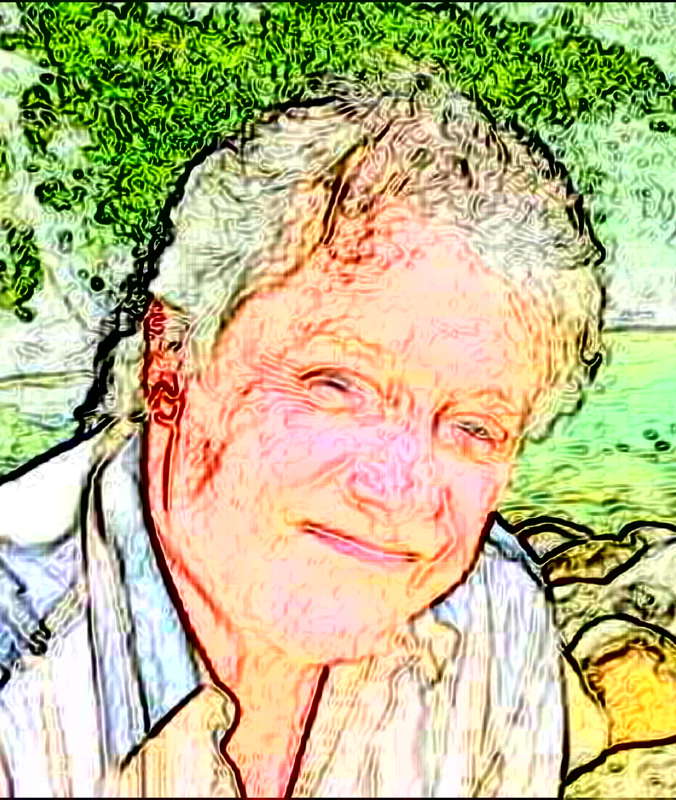- Yaltah Menuhin
- Helen Huntley
- Ihor Markevych
- Sybil Michelow
- contemporary music
- Wolfgang Meyer
- England
- Christoph Koch
Allan Rae: Three Symphonies

A detailed look at some astounding music by one of Canada's great composers
Allan Rae is one of Canada's great composers, having produced an enormous catalogue of music, though his symphonies have not received the attention they deserve. It is clear from a detailed study of the scores that they are important, powerful, beautiful and significant compositions.
Allan Rae was born in Blairmore, Alberta - basically at the junction of two vastly different landscapes: the Great Plains and the Rocky Mountains. To the East lies the Prairie's vast stretches of level land which were once covered in undulating mixed grass and are often blown by fierce and potent winds.

Allan Rae - a psychedelic romp
[A detailed biography of Allan Rae can be found here]
The mountains which rise upwards to the West in massive sheets of mostly sedimentary stone were heaved upwards in cataclysmic volcanic activity a hundred million years ago (called the Crowsnest Formation or the Crowsnest Volcanics) and then battered by extensive glaciers which carved the peaks jagged and rent the valleys harshly and in strange angles revealing cataclysmic changes over vast sequences of time.
Having lived in this landscape, Rae's music alternates between the sonic embodiment of these two geologic forms, but also between the psychic characteristics for which they are metaphors. His music almost always exemplifies these two elements.
Further, one must keep in mind that Allan Rae's music most often begins from a fundamentally meditative posture (or Yogic pose, if you like). Gentle events collect and build, but remain subtle and soft-spoken. It is as if the mind travels across vast fields of prairie with the sky above, the earth beneath and every footfall audible to the solitary wanderer. One hears the subtlest of sounds: the brush of birds' wings, the chirp of the insect, the breeze through the different foliage - each leaf structure makes a slightly different sound.
But then, as if from nowhere - for the mountains seem to sneak up upon the journeyer as he makes his way - there are eruptions of events (usually based on a relentless ostinato) that collect forces, potencies and powers to rise up into solitary massive peaks.
This may seem too poetic, be too purple a passage, but it is essential to gather together the best terms in language as poetry to try to prepare the reader for a sadly silent perusal of the compositions.
Three Symphonies
The Symphony in One Movement subtitled In the Shadow of Atlantis, was completed in 1972. The work is some twenty-five minutes long and is for moderate sized orchestra. Two percussionists are called for and the performance directions for them indicates the care and attention that Rae lavishes upon his music. Apart from the many instruments they are called to play, there are very precise performance indications (how to strike, what mallets to use).
There are also other crucial performance directions for the rest of the orchestra as well. Vibrato is specified (wide or not), key clicks are called for, and most important, directions are given for microtonal inflections. There are instructions for various instruments to use 'extended techniques'. Finally, Rae, who had an extensive background in jazz improvisation (indeed he wrote a book on his methods and the techniques of improvisation far beyond jazz), provides guidance for improvisatory elements in the score. All this before we even discuss the music!
The music begins - as so many of Rae's compositions - from sounds growing from silence. In this case a long held pitch that soon undulates with microtonal activity, like the sighing of the wind. Rae's music draws us inward to hear the most subtle of sounds and events as he prepares us for the meaning that will evolve. This is indeed music that prepares for contemplation. A typically Rae event occurs where metrical time stops and a melody floats for some ten or fifteen seconds and then passes away again. It is as if one hears the cry or call of some ancient avian species with some unknown but profound meaning. Suddenly, and almost by surprise, jagged themes burst into the hushed realm he has created (like those volcanic mountains).
Here, in the first dozen pages is the quintessential Rae: the contrast of prairie and mountain. But we must also keep in mind the subtitle of the work and wonder if Allan Rae had a program in mind, or a source of inspiration. Perhaps he read L Sprague de Camp's (1951/3) book The Tritonian Ring set in Atlantis. Or he was aware of the Atlantis legend as transmogrified by J R R Tolkien in his island of Númenor. Or perhaps he was inspired by the 1940 book by Colonel A Braghine with the same title. Rae mentions Edgar Cayce (known sometimes as the 'Sleeping Prophet') saying recently he 'did read some odd books back in the day'. Such sources are quite the norm for Allan Rae.
Thus, we might say that we are also invited into an imaginary landscape of ancient Atlantis with vast fields of green and also its apocalyptic volcanic activity. By the end of the sonic travelogue we are brought face to face with the cataclysm, and then only for all the lands to sink sadly and quietly into the sea.
Aside on Style and Technique
What does Rae's music sound like? It is not jazz, though he was a jazz trumpet player and band leader and improvisatory events occur. It is influenced by his detailed study of the Schillinger System at the Berklee College of Music in Boston with its mathematical and scientific approach to the creation of interacting sounding events of meaningful and not random aspects. By 1972 however, Rae had retreated from a full blown use of these techniques because he felt them too restrictive.
Most important for a grasp of Rae's music is to note that his harmony is fundamentally tonal with triads often decorated by added minor or major seconds. Progressions occur by movement of such chords by step. The sound world is thus immediately accessible and not some kind of unlistenable esotericism.
A fundamental device of Rae's is the addition of materials into a full complex and then a return to the original simplicity by subtraction. Frequently he will begin a section with a small set of sounds and melodies, then layer another set to the texture and then even a third. Later, he will reverse the process to reduce the sound back to the original minimum.
To create forward motion, Rae uses the ostinato, sometimes at almost inhuman length. The harmony is static and the pulse of the ostinato (either a percussive rhythm or more often a melodic phrase) clear.
These works are demanding and would require careful study, conscientious practice and close rehearsal for effective performance. They are also not suited for listening while jogging or exercising. These are compositions to attend to and be immersed in while listening. For the orchestra careful attention must be paid to Rae's very detailed directions and the conductor will be busy with such directions, cue giving and balance matters. But these are trivial when compared with the internal understanding which must be sought on how to create the atmosphere, create the forward motion, create the contemplative mood and draw the listener along the path through these expansive sonic landscapes. The challenge is great, but the rewards for conductor, orchestra and audience will be equally great.
(I strongly advise that before any performance, a spoken introduction to the nature of the music be provided to the audience to get them into the right 'head space' for listening. This is actually the norm for classical music as program notes, liner notes and spoken introductions prove.)
Symphony #2
Having said that Rae's music usually begins out of silence, this work does not. A large fanfare (twice repeated) announces the beginning and alerts us to the conclusion. But, this work is entitled 'Winds of Change' and so, as we can expect, the sounds of winds, both subtle and torrential are the nature of this composition.
In one movement of multiple sections and completed in 1978, this is a fine example of Rae's method of accumulation of ideas, motifs and activity. For example, the opening fanfare provides the thematic materiel for the next section of wind-form music. Next comes an ostinato section with buzzing woodwinds (which reminds me of a passage in Richard Strauss' Ein Heldenleben). The winds return and then there are interpolations which add or redirect the music. But, not all is quiet and reflective. Violent music derived from the fanfare intervenes. And so on, through the course of the composition, ideas evolve, interact and then return with some addition to a gradual sonic accumulation. The conclusion and climax is a 16th note rushing torrent (of wind) that reminds us that the prairies are the home of tornadoes.
In preparation for this article, I have made extensive notes - perhaps best called scholia - for this score, but decline to present them here in full since I have no sounding examples. But, I am amazed at the intricacy of Rae's design and the complexity of his compositional relations. This is astounding music.
Symphony #3
This work, subtitled 'Alam Al-Mithal' presents a fascinating example of the true art of transcription. It began its existence as a piece for solo piano (premiered in 1979 by Gloria Saarinen) and was symphonically transformed by 1980. It grew from about eighteen minutes in the first, to some thirty in the second incarnation.
There is a segment of the musical world which has viewed transcription as some kind of desperado intrusion upon compositions. Here is a transcription by the composer of one of his own works! Can this not be accepted? Certainly, it must be, just as the art of transcription must be accepted if for no other reason then that J S Bach himself practiced it. Please, the age of debating the propriety of transcription is past. We are now only entitled to ask how well it is done (and in the case of Liszt, Busoni, Ronald Stevenson then the transcriptions are superb). Here too, in Rae's work, is mastery.
It is almost certain that for any work Allan Rae thinks orchestrally (even the simplest work for piano). Thus, it is no stretch to imagine that the piano version (which came first) was heard in his mind with orchestral colours. Please note that the best composers for piano (such as Larry Sitsky) tell that they imagine orchestral colours when composing and that the best pianists (such as Vladimir Horowitz) say they imagine orchestral colours when practising and performing. The Mind is the true source of creativity.
There is a magnificent opportunity to compare the piano version with the expanded orchestral version and see how the one has grown from the other. A doctoral dissertation is called for, but will not be provided here.
Rae's introduction to the term of the subtitle came through the novel Dune (1965) by Frank Herbert and I can think of no better explanation than this by Ali Karjoo Ravary:
'In Dune, Paul must drink the "water of life", to enter (to quote Dune) the "alam al-mithal, the world of similitudes, the metaphysical realm where all physical limitations are removed" ...'
[read 'In Dune, Paul Atreides led a jihad, not a crusade' at Al Jazeera]
What does this term then tell us of the composition? In referring to a transcendental world of imagination (and some kind of reality) this is sometimes compared with Plato's World of The Forms. I leave the details of such philosophic discussions to others. However, for Rae it offered the opportunity to create a work of intimations and suggestions against a background of movement, murmurings, and clear speech as if from another realm. In both its piano and orchestral guise, this is one of Rae's most magical compositions.
I look forward to the day when these works are widely performed, recorded and recognized as an important contribution to modern composition and creativity.
Copyright © 3 July 2023 the author - published anonymously





